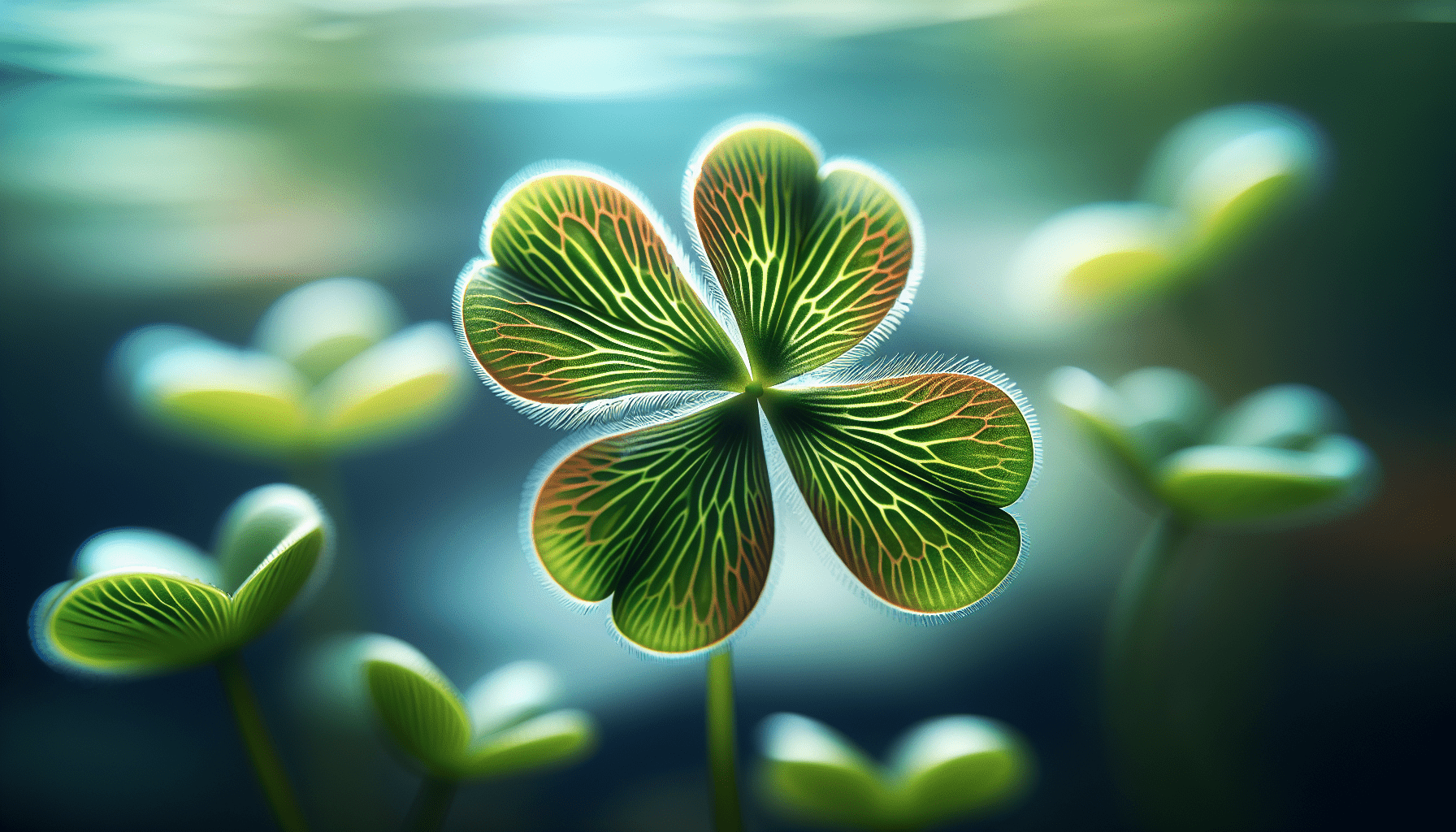As you embark on an exploration into the fascinating world of aquatic botany, one species that might capture your attention is the Marsilea Vestita, commonly referred to as the hairy water clover. Native to the Americas, this aquatic weed garners interest due to its unique manifestations and contributions within its ecosystem. Its peculiar characteristics and genetic diversity make it a compelling topic of study for enthusiasts and researchers alike. This article will elucidate the endearing qualities, habitat, and ecological significance of Marsilea Vestita, providing you with an in-depth look at this intriguing water plant.

Brief Overview of Aquatic Weeds
Definition and Importance of Aquatic Weeds
Aquatic weeds are plant species that thrive in water bodies. They can survive in a variety of water bodies, including rivers, lakes, ponds, and oceans. Often mistaken for nuisance, aquatic weeds play a significant role in the ecological balance. They aid in nutrient cycling, provide habitats for other organisms, regulate water temperature, and even contribute to the oxygen content of water.
Classes of Aquatic Weeds
Aquatic weeds can be classified into three main categories – emergent, free-floating, and submerged. Emergent aquatic weeds such as Albert Grass grow above the water surface, while free-floating weeds, like Duckweed, float on the surface of the water without rooting in the soil. Submerged aquatic weeds, like the Pondweed, grow completely beneath the water surface.
Impacts of Aquatic Weeds on Ecosystems
While aquatic weeds are beneficial to ecosystems, an imbalance can lead to negative consequences such as obstructing water bodies, depleting dissolved oxygen levels, and altering habitats. This could prove harmful to the ecosystem’s aquatic life, hinder recreational activities, and even affect water treatment processes.
Understanding Marsilea Vestita
Definition of Marsilea Vestita
Marsilea Vestita, commonly known as the Hairy Water Clover, is a type of aquatic weed found predominantly in North America. It is a species of the Marsileaceae family and is known for its distinct four-leaf clover-like arrangement and hairy texture.
Characteristics of Marsilea Vestita
Marsilea Vestita, unlike other aquatic plants, defies stereotypic leaf structure. It features leaflets that resemble a four-leaf clover and have a hairy texture, hence the name. The plant has rhizomes, facilitating its growth and spread in suitable environments.
Distribution and Habitat of Marsilea Vestita
As a versatile plant, Marsilea Vestita can withstand varying environmental conditions, from moist soils to shallow and temporary aquatic habitats. It is native to North America but is widely distributed across the continent.
Biological Characteristics of Marsilea Vestita
Plant Structure and Growth
Marsilea Vestita adopts a unique plant structure. Featuring slender rhizomes, scale-like leaves, and sporocarps, the plant exhibits adaptive traits for survival in the aquatic environment. Its growth is facilitated by the extensive network of rhizomes, contributing to its persistent nature.
Reproduction and Life Cycle
Reproduction in Marsilea Vestita involves complex processes of both sexual and asexual methods. The plant produces sporocarps, a specialized structure ensuring the survival of the plant’s spores in unfavorable conditions. The life cycle of Marsilea Vestita is split between two distinct generations, the sporophyte and the gametophyte, a characteristic of ferns.
Adaptation to Aquatic Environments
The capacity of Marsilea Vestita to survive in a broad range of conditions is a testament to its unique adaptive abilities. It can withstand drought conditions by entering dormancy, readily reviving its growth with the onset of suitable conditions. Also, its production of sporocarps ensures the survival of its species during harsh conditions.

Ecological Role of Marsilea Vestita
Role in Aquatic Ecosystems
Marsilea Vestita, like other aquatic plants, plays a significant role in maintaining ecological balance. It aids in oxygen production, nutrient cycling, and serves as a habitat and food source for various creatures, maintaining biodiversity in its environment.
Interactions with Other Organisms
Being a fundamental producer in the ecological food chain, Marsilea Vestita is crucial in supporting various organisms. It provides a source of food and acts as shelter for small aquatic life. Moreover, it acts as a substrate for biofilm communities.
Effect on Biodiversity and Nutrient Cycling
Marsilea Vestita impacts biodiversity by providing habitat and nourishment for a diverse range of organisms, enhancing ecosystem species richness. It also participates in nutrient cycling, contributing to the overall health of the ecosystem.
Cultural Significance of Marsilea Vestita
Use in Traditional Medicine
Marsilea Vestita has been ethnomedically used by Indigenous communities in North America, particularly for its astringent properties.
Use in Landscaping and Decorations
Due to its distinct foliage resembling four-leaf clovers and its adaptive nature, Marsilea Vestita is preferred in aquatic landscaping and decorations. Notably, it serves as a charming addition to water gardens and aquariums.
Cultural Uses and Symbolism
Marsilea Vestita has held cultural significance due to its clover-like appearance. It often symbolizes good luck in various cultures.
Marsilea Vestita as an Invasive Species
Criteria for Invasiveness
An invasive species is characterized by its capacity to spread rapidly, causing harm to the ecosystems they invade. As Marsilea Vestita has an accelerated growth and reproduction rate and can inhabit different habitats, it can be potentially invasive under certain conditions.
Impacts of Invasive Marsilea Vestita
Invasive Marsilea Vestita can have harmful impacts on ecosystems, leading to a decrease in biodiversity, alteration in water chemistry, and even pose threats by creating anoxic conditions detrimental to aquatic life.
Control and Management Strategies
Managing Marsilea Vestita invasiveness involves physical, chemical and biological control methods. Physical control entails manual removal or water level manipulation. Chemical control can be achieved by the use of specific herbicides. Biological methods involve the introduction of its natural predators to limit its growth.
Marsilea Vestita and Water Quality
Effects on Water Chemistry
Marsilea Vestita can alter the water chemistry by changing nutrient levels, specifically nitrogen and phosphorus, possibly leading to eutrophication if left unchecked.
Implications for Water Treatment
The invasive nature of Marsilea Vestita may pose challenges to water treatment processes by blocking filtration systems with its dense growth, proving tedious to remove.
Role in Eutrophication and Algal Blooms
Uncontrolled growth of Marsilea Vestita may lead to eutrophication, a process characterized by excessive nutrient accumulation which can instigate algal blooms, adversely affecting the aquatic life by creating anoxic conditions.
Marsilea Vestita in Aquaculture
Implications for Fish Farming
In fish farming, Marsilea Vestita can be a double-edged sword. It can serve as a source of food and habitat for the fishes, but if unchecked, the dense growth can create an imbalance, causing harm to the fish and other aquatic organisms.
Impacts on Aquatic Food Webs
Being a producer, Marsilea Vestita influences the aquatic food chain by providing sustenance to many organisms. However, if it becomes invasive, it can disrupt this food web by monopolizing resources and nutrients.
Role in Habitat Provision for Aquatic Life
Marsilea Vestita provides habitat for a broad range of aquatic organisms, from microorganisms to aquatic animals, contributing to the ecosystem’s biodiversity.
Conservation Status of Marsilea Vestita
Current Protection Status
While region-specific, the conservation status of Marsilea Vestita mainly depends on the threats it faces, such as habitat loss and pollution.
Threats to Marsilea Vestita
Threats to Marsilea Vestita predominantly consist of habitat alteration, water pollution, and the impact of invasive species which can overshadow marsilea in its native regions.
Conservation Measures and Efforts
Some regions actively work to conserve Marsilea Vestita populations. Measures often include habitat restoration, implementing pollution controls, and managing competing invasive species.
Future Perspectives on Marsilea Vestita
Impacts of Climate Change on Marsilea Vestita
Climate change can induce changes in environmental conditions, which could potentially affect the growth and distribution of Marsilea Vestita. However, the adaptive nature of the plant may enable its survival under changing environments.
Potential for Biotechnological Applications
As climate change becomes more threatening, the adaptive traits of Marsilea Vestita render it a potential candidate for biotechnological applications. Its study could unravel unique survival mechanisms applicable to agriculture and environmental conservation.
Future Research Directions
Owing to the plant’s unique adapative charateristics and ecological significance, future research on Marsilea Vestita should focus on understanding its adaptative mechanisms, potential use in maintaining aquatic ecosystems, and utility in remediation of polluted water bodies.
